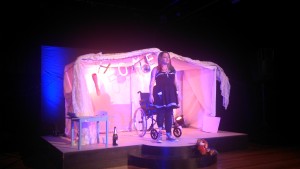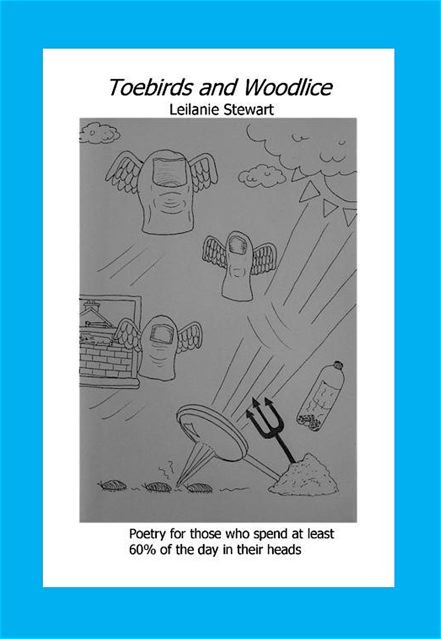Some People Have Too Many Legs by Jackie Hagan (Llanover Hall, Cardiff, 06/03/15)
-Reviewed by Mab Jones-
TimeHop tells Jackie Hagan that it is two years ago today when she was making the pitch for what eventually became this particular show – just before what happened happened, and she became ‘an amputee’. Or, “before my leg got lopped off”, as she puts it, in her inimitable, refreshingly no-nonsense style.
This ‘calling a spade a spade’ aspect is apparent again later in front of her captivated Cardiff audience. Hagan tells us of the time she sought out names for the end of her leg which, a nurse told her, had “healed weird”, and now has a scar which bears some resemblance to a mouth. It looks “like the blonde one out of Birds of a Feather”, the poet tells us. She muses upon the idea of calling it John, but fears that’s too reminiscent of the Elephant Man, and she doesn’t want to make ‘it’ the “Elephant Man in the room”.
This play-on-words is just one of many examples of the wit and humour that pepper the show – or, that glitter it, should I say, glitter being one of several symbols of the world Hagan introduces us to here. For her, glitter isn’t just the cheap and cheerful stuff you find stuck to the odd card or amply scattered across children’s drawings; it represents a mindset that is akin to Hagan’s own – ‘optimistic and imaginative’, bright and sparkly, and able to throw itself at fears with daring, determination, and a twinkle in its made-up, multi-coloured eye.
I enjoyed how these personal symbols were explained and expressed within the show (for don’t we all possess our own personal signifiers, symbolic only to ourselves and shared with select others)? This made the tale feel more intimate, more inviting, and Hagan added to this sense by beginning the show by saying it felt as if she had ‘invited us all into her living room’. We are naturally nosy creatures, who love seeing into each other’s homes, I think, and the stage design was such that it seemed we had stepped into Jackie’s house here, the word ‘home’ itself set in large glittery letters and hung, bunting-like, from the edge of a cocoon-style white tent.
At times, of course, this tent also brought to mind the bed sheets, sterile coverings, and latex gloves of the hospital where much of the action was set. The beep of a heart monitor was the backdrop to some of the storytelling at one point, replacing the upbeat, celebratory music that played at other times. Lights flashed and a ‘dream sequence’ took place during the scene where Hagan’s leg was finally cut off, the fabric of the tent suddenly becoming ominous and overtly-, overly-, overwhelmingly white.
This scene stood in sharp stark contrast to other elements of the show, for instance, the Rainbow Brite doll and teddy bear sat on the steps of the stage, and which were later used to act out a scene in which Hagan communicated with her dead dad. The familiar and the frightening, the comforting and the uncomfortable, were melded together often in this way, Hagan’s false leg acting as an overall, over-arching image to proceedings – her metal ankle decorated with sequins, buttons, and even flashing fairy lights was featured on both the front and back of the show flyer and reminded me of a mascot, a trophy, a chalice filled with wisdom (or wine – and, indeed, Hagan did humorously mime drinking bubbly from her upturned leg towards the show’s conclusion).
Again in interview, Hagan made mention of how much she had changed, due to the story outlined in her show. She shared her various ‘coping mechanisms’ with us, the main one of these being : “all I need to do is be awesome”. Does the writer and performer manage this? Perhaps there was no way she couldn’t have, all considered. We are told that there were dark moments, instances where all she could do was cry; but above all there is the fierce optimism and dogged determination to turn tragedy into something quirkily, crazily beautiful. Hagan’s work is grounded in references to pop culture – children’s toys, telly programmes, “drinking pints of Baileys”, Charlie’s Angels, Gregg’s beans and sausage slices – but the moral of the story is far more than these items, gleefully played with by the artist, might suggest. At heart, there is the hope that we can all deal with difficulties as Hagan herself has done – with “gumption”. “I know that you have had to cope too” the writer states at one point on a held-up placard. And it is thanks to this “optimism”, “imagination” and, in Hagan’s case, “paper and pen”, that we leave the show feeling we could do, too, even if faced with such overwhelming challenges ourselves.
In short, this is a poetic, playful, psychologically-astute piece of theatre which engages the audience’s hearts as well as minds, and I do recommend that you try to see it if you’re able.
Some People Have Too Many Legs is now on tour around the UK, please see http://jackiehagan.weebly.com/ for dates.




